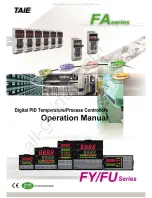
5-
7
5
Parallel I/O interface
1. Standard I/O interface overview
1.6
Dedicated input signal description
1. DI01
Servo-ON input
Use to cancel emergency stop and turn on the servo power (servo-on). (However, the
emergency stop input signal contacts must be closed.)
When the DI01 contact is closed (ON), the servo power turns on at the rising edge of
the signal pulse. If an alarm has been issued it is cleared.
• Input signal pulse width: 100ms minimum
2. DI05
I/O command execution trigger input
DI05 is used to execute an I/O command.
When the command code to be executed is assigned to DI2() and command data to
DI3() and DI4(), and the DI05 contact is closed (ON), the I/O command will be executed
at the rise of the signal. Upon receiving the I/O command, the controller executes the
required task. The progress information during the command execution and decision
results after the command execution are output.
• Input signal pulse width: 100ms minimum
3. DI10
Sequence control input
DI10 is used to execute a sequence program.
When the DI10 contact is closed (ON), a sequence program is executed.
When the sequence program is executed, DO12 (sequence program-in-progress) is
output.
4. DI11
Interlock input
DI11 is used to temporarily stop robot movement during execution of a program or
manual operation of a robot. When the DI11 contact is opened (OFF), the message
“Interlock on” appears and robot operation stops. The program cannot be executed
and robot manual operation is disabled when the DI11 contact is open
5. DI12
Program start input
DI12 is used to start the program.
When the DI12 contact is closed (ON) in “AUTO” mode, the robot program starts at
the rising edge of the signal pulse. DO13 (Robot program-in-progress) is issued when
the robot program is executed.
• Input signal pulse width: 100ms minimum
n
NOTE
If two or more dedicated inputs are
supplied simultaneously or the pulse
width of input signals is too short, the
input signals might not be recognized.
Be sure to provide an interval of about
100ms between input pulses when two
or more dedicated inputs are used.
n
NOTE
The interlock is always engaged if DC
24V is not being supplied to the STD.
DIO connector. A parameter is
available to cancel this status using
the software.
n
NOTE
The rise of DI12 has the same function
as the
START
key.
c
CAUTION
• If a rise of the DI05 signal is
recognized, the robot might begin
to move. In this case, the output
signals of DO(26) and DO(27)
will also change.
• When no I/O commands are used,
set the "IO cmd (DI5) on
STD.DIO/STDPRM" parameter
to "INVALID" by referring to
"12.1.3 Other parameters" in
Chapter 4.
• For detailed information on I/O
commands, refer to the
programming manual.
c
CAUTION
When the program execution is
stopped by a signal such as DI11
(Interlock input), the program re-
executes the command that has
stopped.
n
NOTE
When using a PHASER series robot,
noise is emitted for 0.5 to 2 seconds
during the first servo-on after turning
the power on. This is just the routine
pre-action for obtaining information
needed to control the robot and is not
a problem.
Summary of Contents for RCX141
Page 1: ...User s Manual ENGLISH E YAMAHA 4 AXIS ROBOT CONTROLLER E93 Ver 2 02 RCX141 ...
Page 2: ......
Page 16: ...viii MEMO ...
Page 18: ...MEMO ...
Page 24: ...1 6 MEMO ...
Page 26: ...MEMO ...
Page 34: ...2 8 MEMO ...
Page 36: ...MEMO ...
Page 54: ...3 18 MEMO ...
Page 290: ...4 232 MEMO ...
Page 292: ...MEMO ...
Page 316: ...5 24 MEMO ...
Page 318: ...MEMO ...
Page 326: ...6 8 MEMO ...
Page 328: ...MEMO ...
Page 338: ...7 10 MEMO ...
Page 340: ...MEMO ...
Page 346: ...MEMO ...
Page 401: ...MEMO ...
















































